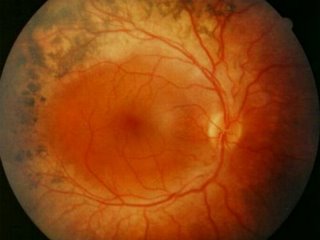Retinitis Pigmentosa

One of the common case in eye station. Be sure that you can recognise this classic case i.e. widespread scattering of black pigment in a pattern resembling bone corpucles.
Don't forget to check for optic atrophy! The examiner will definitely ask you about the optic disc.
Remember these few systemic disorders associated with RP.
1. Laurence-Moon-Bardet-Biedl syndrome
** Autosomal recessive
** Polydactyly ( or check for amputation scar over the hands)
2. Refsum's disease
** Autosomal recessive
3. Hereditary ataxias
4. Familial neuropathies
5. Neuronal lipidoses
6. Kearns-Sayre syndrome










3 Comments:
In refsums disease - look for bilateral hearing aids. A friend of mine did PACES, couldn't see a thing in the fundus but the girl had bilateral hearing aids. He said the diagnosis was refsums and got a 4.
Thanks for the great tip! :)
Usher's syndrome is also another condition with retinitis pigmentosa + bilateral hearing aids
Post a Comment
<< Home